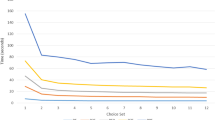Abstract
Standard practice in stated preference typically blurs the distinction between household and individual responses, but without a clear theoretical or empirical justification for this approach. To date there have been no empirical tests of whether values for say a two adult household elicited by interviewing one randomly selected adult are the same as the values generated by interviewing both adults simultaneously. Using cohabiting couples, we conduct a choice experiment field study valuing reductions in dietary health risks. In one treatment a random individual is chosen from the couple and interviewed alone; in the other treatment, both partners are questioned jointly. We find significant differences in household values calculated from joint as opposed to individual responses, with further variation between the values elicited from men and women. Our results question the assumption, implicit in common practice, that differences between individually and jointly elicited estimates of household values can effectively be ignored.
Similar content being viewed by others
References
Adamowicz WL, Boxall P, Louviere JJ, Swait J, Williams M (1999) Stated preference methods for valuing environmental amenities. In: Bateman IJ,Willis KG (eds) Valuing environmental preferences: theory and practice of the contingent valuation method in the US, EU and developing countries. Oxford University Press, Oxford, pp 460–479
Alderman H, Chiappori PA, Haddad L, Hoddinott J, Kanbur R (1995) Unitary versus collective models of the household—is it time to shift the burden of proof. World Bank Res Obs 10(1): 1–19. doi:10.1093/wbro/10.1.1
Arora N, Allenby GM (1999) Measuring the influence of individual preference structures in group decision-making. J Mark 25(November): 476–487
Bateman IJ, Munro A (2003) Testing economic models of the household: an experiment. CSERGE working paper, University of East Anglia, Norwich
Bateman IJ, Munro A (2005) An experiment on risky choice amongst households. Econ J 115(502): C176–C189. doi:10.1111/j.0013-0133.2005.00986.x
Becker GS (1974) A theory of social interactions. J Polit Econ 82(6): 1063–1093. doi:10.1086/260265
Beharry N, Scarpa R (2006) Joint vs separate decisions with taste variation: exploring responses of couples in choice experiments for coastal water quality valuation in Tobago. Paper presented at the third world congress of environmental and resource economists, Kyoto, Japan, 3–7 July 2006
Bennett J, Blamey R (eds) (2001) The choice modeling approach to environmental valuation. Edward Elgar, Cheltenham
Bergstrom T (2003) Benefit cost analysis and the entanglements of love. U.C., Santa Barbara
Browning M, Chiappori P-A (1998) Efficient intra-household allocations: a general characterization and empirical tests. Econometrica 66(6): 1241–1278. doi:10.2307/2999616
Dellaert BGC, Prodigalidad M, Louviere JJ (1998) Family members’ projections of each other’s preference and influence: a two-stage conjoint approach. Mark Lett 9(2): 135–146. doi:10.1023/A:1007904931283
Dosman D, Adamowicz W (2006) Combining stated and revealed preference data to construct an empirical examination of intra-household bargaining. Rev Econ Househ 4: 15–34. doi:10.1007/s11150-005-6695-1
Dupont DP (2004) Do children matter? An examination of gender differences in environmental valuation. Ecol Econ 49(3): 273–286. doi:10.1016/j.ecolecon.2004.01.013
FAO (1994) Fats and oils in human nutrition: report of a joint expert consultation. Food Agricultural Organization, Rome
Hensher DA, Greene WG (2003) The mixed logit model: the state of practice. Transportation 30(2): 133–176. doi:10.1023/A:1022558715350
Hensher DA, Shore N, Train K (2004) Households’ willingness to pay for water service attributes. Environ Resour Econ 32(4): 509–531
Kerr NL, MacCoun RJ, Kramer GP (1996) Bias in judgment: comparing individuals and groups. Psychol Rev 103(4): 687–719
Louviere JJ, Hensher D, Swait J (2000) Stated choice methods: analysis and application. Cambridge University Press, Cambridge
Lundberg SJ, Pollak RA, Wales TJ (1997) Do husbands and wives pool their resources? Evidence from the United Kingdom child benefit. J Hum Resour 32(3): 463–480. doi:10.2307/146179
Munro A (2005) Household willingness to pay equals individual willingness to pay if and only if the household income pools. Econ Lett 88: 227–230
Phipps SA, Burton PS (1998) What’s mine is yours? The influence of male and female incomes on patterns of household expenditure. Economica 65: 599–613. doi:10.1111/1468-0335.00148
Quiggin J (1998) Individual and household willingness to pay for public goods. Am J Agric Econ 80: 58–63. doi:10.2307/3180268
Samuelson PA (1956) Social indifference curves. Q J Econ 70(1): 1–22. doi:10.2307/1884510
Strand J (2007) Public-good valuation and intra-family allocation. Environ Resour Econ 38: 527–543
Swait J, Louviere JJ (1993) The role of the scale parameter in the estimation and comparison of multinomial Logit Models. J Mark Res 30: 305–314. doi:10.2307/3172883
Teal GA, Loomis JB (2000) Effects of gender and parental status on the economic valuation of increasing wetlands, reducing wildlife contamination and increasing salmon populations. Soc Nat Resour 13(1): 1–14. doi:10.1080/089419200279207
Train K (1999) Halton sequences for mixed logit. Department of Economics, University of California, Berkeley
Author information
Authors and Affiliations
Corresponding author
Rights and permissions
About this article
Cite this article
Bateman, I.J., Munro, A. Household Versus Individual Valuation: What’s the Difference?. Environ Resource Econ 43, 119–135 (2009). https://doi.org/10.1007/s10640-009-9268-6
Received:
Accepted:
Published:
Issue Date:
DOI: https://doi.org/10.1007/s10640-009-9268-6




